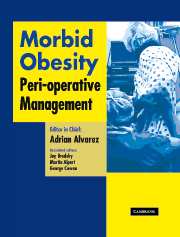Book contents
- Frontmatter
- Contents
- Contributors
- Foreword
- Preface
- Acknowledgments
- Dedication
- Section 1 General aspects
- Section 2 Pathophysiology
- Section 3 Pre-operative management
- Section 4 Peri-operative management of co-morbidities
- Section 5 Pharmacology
- 15 Pharmacokinetics and pharmacodynamics: essential guide for anesthetic drugs administration
- 16 Remifentanil in morbidly obese patients
- Section 6 Monitoring
- Section 7 Intra-operative management
- Section 8 Post-operative care
- Section 9 Conclusions
- Afterword
- Index
16 - Remifentanil in morbidly obese patients
from Section 5 - Pharmacology
Published online by Cambridge University Press: 17 August 2009
- Frontmatter
- Contents
- Contributors
- Foreword
- Preface
- Acknowledgments
- Dedication
- Section 1 General aspects
- Section 2 Pathophysiology
- Section 3 Pre-operative management
- Section 4 Peri-operative management of co-morbidities
- Section 5 Pharmacology
- 15 Pharmacokinetics and pharmacodynamics: essential guide for anesthetic drugs administration
- 16 Remifentanil in morbidly obese patients
- Section 6 Monitoring
- Section 7 Intra-operative management
- Section 8 Post-operative care
- Section 9 Conclusions
- Afterword
- Index
Summary
Introduction
The use of opioids is almost essential in the anesthesiological practice nowadays. Many clinical benefits can be observed by the use of morphins, such as autonomic stability, blocking response to surgical stress, good to excellent hemodynamic conditions to improve myocardial oxygenation and capability to reduce the required doses of other agents (such as hypnotics) between others. Unfortunately, use of opioids in this particular population (principally in large doses or long lasting infusions) is limited and even dangerous due to pharmacokinetic and -dynamic alterations (see Chapter 15).
Latter distribution might result in variable adverse effects, such as delay in recovery, respiratory depression, muscle rigidity, cardiac dysfunction, nausea, vomiting and “resedation phenomenon”. This is related to the redistribution of lipophilic/sedative agents from the fatty tissue back into the bloodstream. The resedation phenomenon is compounded by the very high risk of obstructive sleep apnea (OSA) and upper airway resistance syndrome (UARS) seen in these patients.
Respiratory system function is significantly altered in the obese (see Chapter 4). It has been noted that a body mass index (BMI) of one standard deviation above the mean is associated with a 4-fold increased risk of obstructive sleep apnea syndrome (OSAS).
Prevalence of OSAS in general USA population is 2% in women and 4% in men, but increases up to 3–25% in women and 40–78% in men if they are morbidly obese.
- Type
- Chapter
- Information
- Morbid ObesityPeri-Operative Management, pp. 223 - 240Publisher: Cambridge University PressPrint publication year: 2004

